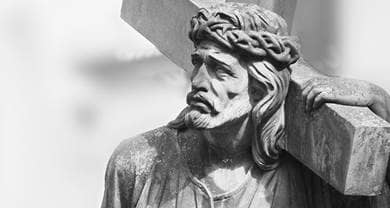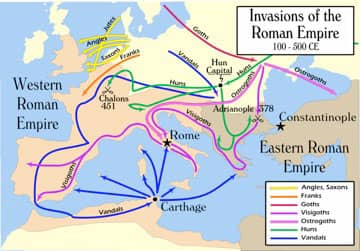- Trending:
- Pope Leo Xiv
- |
- Israel
- |
- Trump
- |
- Social Justice
- |
- Peace
- |
- Love

RELIGION LIBRARY
Christianity
Missions and Expansion
Only a few decades after Emperor Theodosius I declared Christianity the official religion of the Roman Empire, the Western Empire came to a painful and symbolic end when the Visigoths sacked Rome. Such former Roman strongholds in what are known today as North Africa, Sicily, Italy, France, Spain, and Britain were thrown into political chaos and uncertainty, and the ensuing centuries were characterized by nearly endless warfare and plunder. Against this backdrop, the Western, Latin-speaking church, centered in Rome, expanded into the territories of modern-day Western and Central Europe, and grew in power and influence.

Meanwhile, the Eastern Roman Empire, or Byzantine Empire, continued to enjoy security and wealth. Constantinople served as the political and spiritual center for Greek-speaking Christians whose communities were thriving in Greece, Asia Minor (modern-day Turkey), Palestine, and Egypt. The Christian Byzantine Empire lasted through fluctuating fortunes until the Ottoman conquest in 1453. During these thousand years, the Byzantine church spread north and east from present-day Greece, Turkey, and Hungary, but lost contact with the important religious centers of Antioch, Alexandria, and Jerusalem in the Muslim conquest of the 7th century.
 The growth of the monastic movement in the 4th and 5th centuries provided the basis for the missionary efforts of the eastern and western churches. Basil of Caesarea (c. 330-379) wrote rules for monastic living for Greek-speaking monks, which are still followed in Orthodox Christianity. Benedict of Nursia (c. 480-547) wrote the Rule of Benedict for Latin-speaking monks, which is still in use in Benedictine monasteries. These rules sustained strong organizational structures that allowed monks, scribes, and missionaries to travel great distances spreading Christian teachings. In their effort to win converts, monks traveled throughout Europe, building churches and monasteries wherever they went. In some circumstances, the conversion of rulers or generals meant the conversion of peoples or armies. In other circumstances, Christianity permeated the daily life of villages or towns, weaving people together into nations sharing a common language and belief.
The growth of the monastic movement in the 4th and 5th centuries provided the basis for the missionary efforts of the eastern and western churches. Basil of Caesarea (c. 330-379) wrote rules for monastic living for Greek-speaking monks, which are still followed in Orthodox Christianity. Benedict of Nursia (c. 480-547) wrote the Rule of Benedict for Latin-speaking monks, which is still in use in Benedictine monasteries. These rules sustained strong organizational structures that allowed monks, scribes, and missionaries to travel great distances spreading Christian teachings. In their effort to win converts, monks traveled throughout Europe, building churches and monasteries wherever they went. In some circumstances, the conversion of rulers or generals meant the conversion of peoples or armies. In other circumstances, Christianity permeated the daily life of villages or towns, weaving people together into nations sharing a common language and belief.
 Monks of the Eastern Orthodox Church spread north and east from Constantinople. Sts. Cyril and Methodius, remembered as "apostles to the Slavs," took the Christian message to the Slavic peoples in the mid-9th century. In 860, Khan Boris, leader of the Bulgars (a semi-nomadic people in eastern Europe), was baptized. The Byzantine Patriarch sent missionaries to Russia, but their mission ended in 878. A century later, however, Prince Vladimir of Kiev was baptized, and Christianity continued its spread among the diverse tribes in the vast lands of Russia.
Monks of the Eastern Orthodox Church spread north and east from Constantinople. Sts. Cyril and Methodius, remembered as "apostles to the Slavs," took the Christian message to the Slavic peoples in the mid-9th century. In 860, Khan Boris, leader of the Bulgars (a semi-nomadic people in eastern Europe), was baptized. The Byzantine Patriarch sent missionaries to Russia, but their mission ended in 878. A century later, however, Prince Vladimir of Kiev was baptized, and Christianity continued its spread among the diverse tribes in the vast lands of Russia.  The Byzantine mission to the Slavs contributed significantly to creating a cultural, linguistic, and political sensibility through which the modern nations of Ukraine, Bulgaria, Russia, and Serbia emerged.
The Byzantine mission to the Slavs contributed significantly to creating a cultural, linguistic, and political sensibility through which the modern nations of Ukraine, Bulgaria, Russia, and Serbia emerged.
Missionaries from the Western Church traveled north and west from Rome.  King Clovis of the Franks (a northern European tribal group) was baptized in 498 at the urging of his Christian wife Clotilde, thus solidifying the influence of the Church in western Europe. While some people groups, like the Celts and the English, converted through marriage and missionary contact, others succumbed to forced conversion. Between 772 and 804, the Frankish King Charlemagne pursued a policy of military conquest followed by the execution of all Saxons (another Germanic tribal group) who refused baptism. The Roman Church's mission to the Germans, Franks, Saxons, Celts, and English provided the foundation for Western Europe's sense of cultural unity.
King Clovis of the Franks (a northern European tribal group) was baptized in 498 at the urging of his Christian wife Clotilde, thus solidifying the influence of the Church in western Europe. While some people groups, like the Celts and the English, converted through marriage and missionary contact, others succumbed to forced conversion. Between 772 and 804, the Frankish King Charlemagne pursued a policy of military conquest followed by the execution of all Saxons (another Germanic tribal group) who refused baptism. The Roman Church's mission to the Germans, Franks, Saxons, Celts, and English provided the foundation for Western Europe's sense of cultural unity.

| Important Differences | |
| Eastern Church | Western Church |
| Part of Greek-speaking Byzantine Empire | Roman church speaks Latin |
| Bible and liturgy tend to be in indigenous languages | Bible and liturgy are read in Latin |
| Local autonomy in church affairs | Local clergy is subject to the pope in Rome |
| Not involved in functioning politics and focuses instead on theological concerns | Heavily involved in politics |
There were important cultural differences between the eastern and western churches. The Byzantine Empire was Greek-speaking, while the Church in Rome spoke Latin. Missionaries from the Eastern Church tended to translate the Bible and the liturgy into indigenous languages. They also encouraged locals to enter the clergy and nurtured local autonomy in the running of church affairs. Missionaries from the Western Church commonly required that converts use a Latin Bible and liturgy, mandated the local clergy's hierarchical subjugation to the pope, and required the clergy to be celibate.
Moreover, the Eastern Church was geographically and politically close to the Emperor in Constantinople, while the Church in Rome was often the sole source of political authority and stability in the political chaos of the former Western empire. As a result, the Western Church became distinctive for its focus on practical, administrative matters and on providing stability and order, including an emphasis on the pope as the single and supreme authority. Thus, the Western Church was heavily involved in the politics and power of governance. In contrast, the Eastern Church's reliance on functioning imperial powers enabled them to focus on theological speculation and to insist upon church autonomy from secular rulers.

Both the Eastern and Western churches were powerfully affected by the spread of Islam. During the first century following the death of Muhammad in 632, Islam spread rapidly west, conquering some of the important patriarchates of the Eastern Church, including Antioch, Alexandria, and Jerusalem. At the same time, Muslim armies spread across North Africa, eventually conquering Spain. The Muslim conquest of Christian land was finally broken when, in 732, the Frankish King Charles Martel turned back the vast Muslim army at Tours in France.
The Eastern and Western churches alternately cooperated and competed, whether in the mission field or in ecclesiastical and political matters. Ultimately, the geographical, cultural, and political distances between them proved too great to sustain Christian unity, and in the Middle Ages, the Church experienced two profound and to-date irreversible schisms.
Study Questions:
1. How was the Church divided after Emperor Theodosius I?
2. Why was the monastic order crucial to the spread of Christianity?
3. How did the mission efforts of the Eastern and Western Church differ?
4. What religious tradition was a powerful competition to the spread of Christianity? Why?










